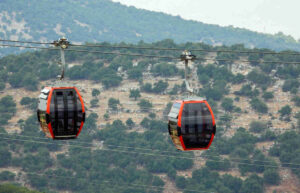The Siq is the main entrance to Petra (not to be confused with the backdoor, to which we dedicated this other post). Most visitors enter through here, and centuries ago it was also the overwhelming access for those who passed through here, for commercial, religious or other purposes. So if you come to Petra through this entrance, you will travel it on foot or in a golf cart, so you will find it interesting to know the following curiosities.
The name: what it means
The Siq is a narrow rocky canyon, of great length, imposing height and, in some sections, very little width, as we will see in the following points. However, its meaning in Arabic (al-Siq) is not that of canyon or gorge, but that of axis. In other words, the local inhabitants themselves, in this case from the Arab conquest in the seventh century, conceived it as the axis of this city.
Surprising length
If we add up all the sections of the Siq, its length is 1.2 km in total. Its beginning was crowned by an arch that was lost, while its end is marked by the imposing Treasury. Between both points, a spectacular walk that, for many, is the most fascinating kilometer ever traveled.
Very narrow width in many sections
The width of the Siq is variable, everything depends on each section. But what is most striking is, without a doubt, its narrowness at some points, as there are barely 3 meters from one wall to another.
Spectacular height
The feeling of narrowness is amplified by the high height of the canyon walls, which ranges from 90 meters to almost 190 meters at some points. As a result, the sun’s rays barely reach the ground at many points along the route.
Not (initially) caused by erosion
Most canyons of this type (known as ‘grooves’) originate from the erosive work of the bed of a small river, which creates that slot encased between the rock walls. However, in the case of the Siq, no: it originated due to tectonic movements, although later the water that flowed through here deepened it.
Dikes, in the middle of Siq
Indeed, strange as it may seem, water flowed through here: not from a river but from the torrents caused by the heavy rains, which sought their way to Wadi Araba, in the end. For this reason, both the Nabataeans and later civilizations built dikes that contained this water and prevented its entry into the Siq. But that must not have been enough, as several great floods devastated the city, one of the largest sometime in the first century BC – I AD. Even today, the remains of the old dikes and other more modern ones, in the form of a dam, are visible.
It has its own aqueduct
The concern for water was not only to protect themselves from it, but above all to channel it to the city and thus supply this basic element to the population. And on the walls of the Siq you can still see grooves through which the water flowed, like an aqueduct.
Remains of statues and betyls
To understand what the Siq was like at the time of Petra’s heyday, you have to imagine its walls decorated with symbolic and imposing elements. For example, statues, probably in honor of Nabataean gods, of which some remains remain embedded in the rock, such as legs or even entire bodies. And also betyls: niches or niches where some type of inscription or plaque dedicated to a divinity was housed.
These are just a few curiosities of the Siq of Petra, but there must be many more. And we say this as a guess, because in reality there is still a lot to discover here: according to some experts, 80% of the city still has to be excavated, which would help improve the knowledge of Petra and this particular canyon.



